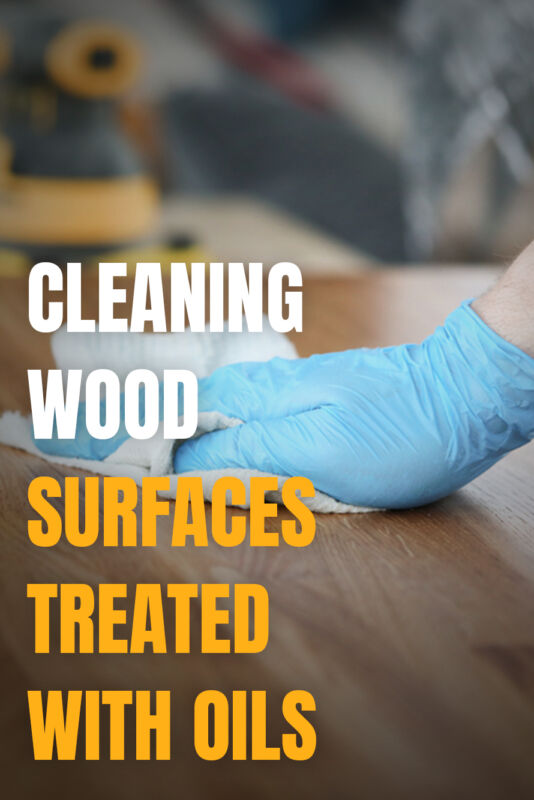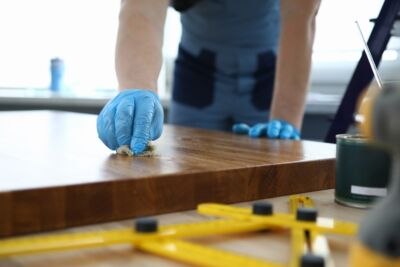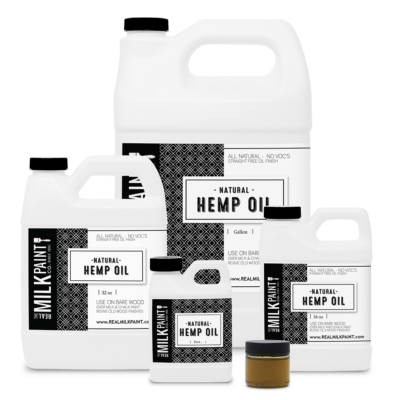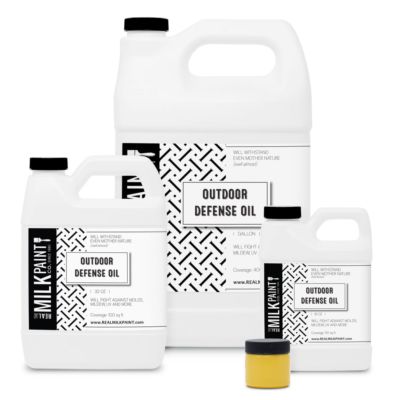 Cleaning wood surfaces treated with oils requires special care to maintain their beauty and extend their longevity. Though eco-friendly wood oils such as hemp and tung oil from the Real Milk Paint Co. create a protective finish safe for food contact, application and curing are only the first steps to caring for wooden surfaces. Properly cleaning oil-treated wood matters just as much as the initial treatment, so let’s discuss what that looks like for the various types of oils. Here, we explore regular and deep-cleaning tips, techniques for handling spills and stains and advice for re-oiling wooden surfaces.
Cleaning wood surfaces treated with oils requires special care to maintain their beauty and extend their longevity. Though eco-friendly wood oils such as hemp and tung oil from the Real Milk Paint Co. create a protective finish safe for food contact, application and curing are only the first steps to caring for wooden surfaces. Properly cleaning oil-treated wood matters just as much as the initial treatment, so let’s discuss what that looks like for the various types of oils. Here, we explore regular and deep-cleaning tips, techniques for handling spills and stains and advice for re-oiling wooden surfaces.
Regular Cleaning Tips for Wood Furniture
Regular dusting maintains the beauty of oiled wood furniture by preventing dirt buildup. Over time, dust and dirt settling on wood can make it look dull and more scratch-prone. Dusting frequently using a soft cloth like a lint-free microfiber rag keeps furnishings free of debris for a well-preserved look, whether polishing an antique or a piece you made yourself.
Also, avoid abrasive cleansers when cleaning oil-treated wood. Harsh chemicals strip away natural oils over repeated use, leaving dryness, cracking and discoloration in their wake. These cleansers also damage the protective finish left behind by wood oils, making surfaces more vulnerable to wear and moisture, so use natural options when possible.
Follow these steps for regular cleaning:
- Remove loose dirt and debris with a soft, lint-free cloth.
- Mix warm water with a small amount of mild detergent and a few drops of white vinegar.
- Dip a clean cloth into the cleaning solution and wring it out before gently wiping the wood surface, following the grain.
- Wet another clean cloth with clean water to wipe off residue.
- Dry the wood surface with a clean, dry cloth.
- If the wood looks dull after it dries, condition the area with wood oil to preserve wood sheen and health.
To keep your wood furniture looking its best between regular cleanings, consider moving it out of direct sunlight to avoid UV damage. Additionally, keep rooms at a consistent humidity level to prevent cracking and warping. Use coasters and placemats to reduce the risk of water rings from glasses and heat damage from coffee cups.

Deep Cleaning Techniques for Wooden Furniture
Though regular dusting goes a long way in cleaning wood surfaces treated with oils, deep cleaning wood furniture helps it stay beautiful over time. Use these steps to safely clean your pieces:
- Prepare the surface by using the steps for regular cleaning.
- Inspect the wood for any stains or grimy areas.
- Use a solution of equal parts water and white vinegar to clean the area.
- For tougher surfaces, clean with an eco-friendly cleanser such as EMERGE cleaner and degreaser.
- Wet a clean rag in the cleaning solution, then wipe down the surface.
- If stubborn stains remain, use 0000-grade steel wood to gently scrub the area, following the wood grain.
- Wipe the spot with a clean, damp cloth to remove any residue.
- Dry the area with a clean, soft rag, then re-oil the wood.
We recommend using mild soap and water for deep cleaning wood treated with oil, but some surfaces require extra help. Combine equal parts white vinegar and water to disinfect a surface, lift heavy grease and grime or remove stains and odors that linger with other cleaning solutions.
Handling Stains and Spills on Wood Furniture
Dealing with spills requires fast response times for the best results. Wiping up spills when they occur reduces the risks of staining and prevents moisture from penetrating wood fibers and damaging the finish. Keeping paper towels and cleaning cloths nearby lets you handle spills when they occur, but sometimes life gets in the way. In those instances, use these techniques to remove stains.
- Water stains: Blot with a dry cloth to soak up all the excess water. If that doesn’t work, place a dry cloth on the stain, then glide a warm iron over it (steam off) to remove excess moisture. Finish by wiping off the residue with clean water and using a dry cloth to remove all moisture.
- Food stains: A solution of mild soap and water usually takes off food stains. If it doesn’t, apply the baking soda and water paste mentioned above with a soft cloth, rinse the area with clean water and dry it with a clean cloth.
Re-Oiling Wooden Surfaces
After cleaning wood surfaces treated with oils, you may notice signs that they need a few fresh coats of wood oil. The main indications that you need to re-oil furniture are a dull, dry look and a rough surface feel. Your wood may also stain more easily or retain water marks when it needs more nourishment. In extreme cases, the wood may split or crack without proper care and re-oiling.
Follow these steps to add more wood oil to a wooden surface.
- Dust the surface with a damp cloth to remove any dirt and debris.
- Look for any spills and stains, spot-clean them as needed, and dry the surface.
- Grab a clean, dry cloth and apply oil (we recommended using the same oil the wood was originally finished with) to the surface, wiping away any excess oil.
- Let the first coat absorb, then repeat the process until the surface can’t hold any more wood oil. Typically only one or two applications is enough for maintenance.
- Let wood furniture dry or cure the proper amount of time before use to avoid damaging the re-oiled surface.
Wood Treatment Oils to Re-Oil Wood Surfaces
 Treat wood with oil to enrich the appearance of wooden furniture and furnishings. Wood oils’ unique protective properties preserve and beautify surfaces, enabling simple maintenance. Eco-friendly formulas like those from the Real Milk Paint Co. ensure sustainability, longevity and appealing aesthetics.
Treat wood with oil to enrich the appearance of wooden furniture and furnishings. Wood oils’ unique protective properties preserve and beautify surfaces, enabling simple maintenance. Eco-friendly formulas like those from the Real Milk Paint Co. ensure sustainability, longevity and appealing aesthetics.
Types of Wood Oils for Furniture Treatment
Various wood oils work well on furnishings, but each has specific properties that make it best in certain situations.
Tung Oil
Cold-pressing the seeds of the chinawood tree produces tung oil, a wood oil that soaks into the pores for excellent water resistance. This wood oil cures via polymerization rather than oxidation, so you get a durable, flexible matte finish that enhances the natural beauty of the wood grain. The only downside to products like Pure Tung Oil is their long curing times — you have to wait 30 days to fully use your piece in most cases.
Hemp Oil
Derived from industrial hemp seeds, hemp oil offers a sustainable way to protect wood. It penetrates deeply for a food-safe finish ideal for kitchen utensils, cutting boards and butcher blocks without the need for thinning with a solvent. The matte finish accentuates the wood grain, creating a smooth surface that works on diverse pieces, from bare wood to furniture covered in Real Milk Paint. Curing times run around 30 days, so consider this when choosing wood oils for your projects.
Linseed Oil
Sustainable linseed oils apply easily and typically dry within a week, protecting wooden furniture from environmental damage. However, this finish also scratches easily, and humidity changes may trap moisture beneath it, potentially promoting mold and mildew growth. You also need to check the type of linseed oil you’re using — simple linseed oil often provides a food-safe finish, but boiled linseed oil doesn’t due to the harsh chemical additives that speed up drying times.
The Benefits of Natural Oils
 These eco-friendly, non-toxic oils make your home more comfortable and safe indoors and around kids and pets. Natural wood oils also bring out the best in wood grain for a warm, rich look. Unlike their synthetic counterparts, these sustainable products nourish oiled wood surfaces while letting them breathe so they stay strong and flexible.
These eco-friendly, non-toxic oils make your home more comfortable and safe indoors and around kids and pets. Natural wood oils also bring out the best in wood grain for a warm, rich look. Unlike their synthetic counterparts, these sustainable products nourish oiled wood surfaces while letting them breathe so they stay strong and flexible.
How Wood Oils Enhance Beauty
Deep penetration into wood fibers builds a resilient defense against moisture, dirt and wear. Using wood oils to protect furnishings from warping and splitting also accentuates the grain and color, helping you showcase the natural beauty of your home decor.
Keep Oiled Wood Surfaces in Top Condition
These tips for cleaning wood surfaces treated with oils let you keep wooden furniture looking its best. Products from the Real Milk Paint Co. help with this process by delivering a durable, water-repellent finish that’s eco-friendly and simple to maintain. Discover the perfect wood oil for your furniture by shopping our selection today.



